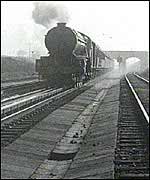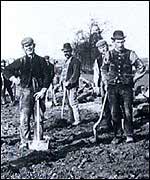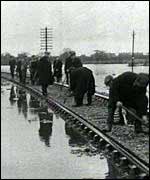|
Meet the men and women who kept the railway running through
50 years of hard work, unexpected changes and slow decline.
Experience the working lives of the railway workers,
and go inside the troubled story of half a century on the railways.
We take you on a train journey which starts with the
romanticised, golden age of steam and ends on the diesel revolution and
the gradual decline of the rail network.
The Golden Age of Steam
Since the birth of railways, trains have ferried thousands
of passengers on the east coast mainline as well as on suburban and rural
lines.
 |
| Steam trains were hot and dirty but exhilarating
for drivers |
Join the crowds on York Station in the 1920s at the peak
of the railway boom in York Travelogue.
This period is often seen as a romantic, golden era
when steam trains steamed their way across the countryside with plumes
of smoke puffing high into the sky.
Eavesdrop on railway drivers as they debate the merits
of steam against the new diesel trains in a Sheffield social club in the
documentary Engines Must Not Enter the Potato Siding (1969).
Watch former rail man Allan Richardson talking about
how his job could be filthy, with dirty oil and grease from the engines
getting everywhere.
Listen to Allan describing the exhilaration of driving
a steam engine - "a marvellous feeling", and "being roasted"
by the extreme heat from the engine.
Steam kings
The Flying Scotsman was the king of steam, the first
steam train to crash the 100 mph barrier. Built in Doncaster in 1924,
the train is still regarded as the pinnacle of all that was best about
steam.
 |
| The Flying Scotsman was arguably the greatest steam
engine of its age |
Take a seat on board the classic train in the film Still
in Steam which shows the engine's last trip from King's Cross to Doncaster
in 1963.
The Scotsman had travelled 2 million miles by the end of its working life.
Watch the restoration of the Flying Scotsman by enthusiasts,
and see remarkable footage of the train being taken by ship to the United
States in USA Tour (1969).
Join the Flying Scotsman (19??) on a day out from
London to Nottingham and Gloucester as it relives the glory days of steam
trains in a film with entertaining narration by Johnny Morris.
A Dangerous Job
Working on the railways could be a dangerous profession
particularly in the days before health and safety regulations.
Accidents were commonplace, and longer term diseases
such as asbestosis were a longer term occupational hazard.
 |
| Railway workers in the 1840s contracted cholera |
Engines Must Not Enter the Potato Siding (1969)
shows how twenty eight railway workers died in a cholera epidemic in 1849
when working on the railway.
Stone Blasting (194?) shows men blasting limestone
for ballast at a quarry in Barnard Castle in County Durham. There was
always the threat of hearing damage as there were no noise mufflers, and
being hit by fall-out from the blast could be fatal.
During the Second World War there were many more dangers.
Mustard Gas (194?) shows rail workers in a secret training exercise
against a gas attack, wearing protective clothing and gas masks.
Modern rail workers weren't immune from uncomfortable
conditions. Watch drivers in the 1970s complaining about grime-filled,
suffocating, airless railway tunnels in the film Engines Must Not Enter
the Potato Siding (1969).
Stormy Weather
Workers often had to contend with severe weather conditions.
Snow (1947) is an illuminating film shot by a cameraman for the
old London and North East Railway Company.
 |
| Rail workers had to endure treacherous weather |
It shows an army of rail workers trying to clear a mountain
of snow high up on the Yorkshire Moors to free a train stuck in a drift.
The film illustrates how workers had only basic equipment
to cope with atrocious weather conditions which included waist-high snow.
Eventually snow blasters were brought in to shift the snow, a modern innovation
for the time.
After the snow came the floods together with track damage
which needed to be repaired if the trains were to run on time. Watch workers
battling to repair the tracks in Repairing Damage (1947).
Behind the Scenes
York was one of the major hubs of the rail network, acting
as an important passenger interchange and employing hundreds of men in
railway workshops.
Railway Summer Services(1949) is a fly-on-the-wall
look behind the scenes at York station which captures the various aspects
of station life including the work of the locomotive workers, the signal
men, timetable schedulers, the station announcers and the publicity department.
Go inside the Signal Workshops (19??) at York
Station in a film looking at signal repair and the assembly of signal
boxes. Watch the cleaning out of the slut and slag from xxxx , a messy
but essential job.
Rail Towns
Relive over a century of steam in a film celebrating
the 125th anniversary of Doncaster station featuring the Royal Scotsman,
the Blue Peter and the Bahamas in 1978.
 |
| Station life in Penistone |
Watch the crowds admiring the classic trains which were
built in the town. Doncaster employed 3,000 railway men, working 12 hours
a day, six days a week at the turn of the century.
Take a trip to Market Weighton Station in 1965
with rare footage from the Marsden film collection, and see how the goods
trains moved freight up and down the line, an important function of the
railways in the mid 1960s.
Visit Normanton, a Yorkshire town built on railways and
coal, but now in decline in the BBC film Railmen (1975). This was
the station where Queen Victoria and Gladstone changed trains, and which
once was the second largest rail junction in the country.
Watch wagon repairer Bernard McGreevy talking about how
his status as a worker had declined with his take home pay packet of just
£35 per week compared with £55 for a pit man.
The Modern Revolution
Engines Must Not Enter the Potato Siding (1969)
shows the transition from steam to diesel on the Sheffield to Manchester
line, the first to be electrified.
 |
| All aboard! |
The film also illustrates how stations were changing
and being modernised. Stop off at Euston in London and see the gleaming
new station architecture with its aluminium, steel, and glass designs.
Buy a cup of tea in the station café with its
fashionable plastic fixtures and spend slightly more than a penny in the
new-style 6d superloo.
Go inside the control room with its state of the art
electric power box and hi-tech gadgetry.
Euston was seen as a new departure in station architecture
and a flagship for cleaner, more efficient and faster railways.
End of the Line
After the Second World War the railway system was nationalised
and a gradual decline started. This was accelerated by the Beeching Report
in 1963 which resulted in the closure of many branch lines.
Watch former signal man Syd Walker talking about the
demise of smaller stations like Market Weighton near York which
closed in 1965.
Railmen (1975) shows how
Yorkshire rail workers were becoming more disillusioned by the decline
of the railways. Watch as they talk poignantly about threats to the future
of railway communities.
Credits and Contacts
Photograph of the Green Arrow courtesy of the National
Railway Museum, York.
Yorkshire Film Archive - 01904 716 550.
|

